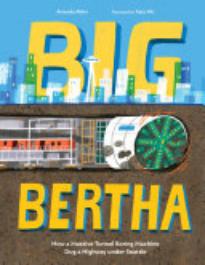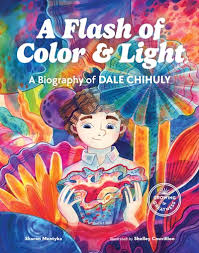Sasquatch/Little Bigfoot
23 Reviews
(3)
K-3
Illustrated by
Katy Wu.
This engaging nonfiction picture book details the SR 99 Tunnel project in Seattle, focusing on the journey of Bertha, a massive tunnel-boring machine, as she digs through the city. With a compelling text and mid-century-modern-style illustrations, the book illuminates the complex engineering behind the project and Bertha’s impressive feats. Back matter packed with fascinating facts and additional resources rounds off this title that’s sure to please young construction enthusiasts.
Reviewer: Summer Edward
(2)
K-3
Illustrated by
Shelley Couvillion.
Dale Chihuly (b. 1941) was drawn to light, color, and glass from an early age. As a young man, a formative trip to Europe and Israel sparked his interest in glassblowing as an art form. When he returned home, he enrolled in a newly established studio program and perfected his craft among a community of artisans before returning to Venice to learn from the very best. Glassblowing quickly became his life, and when he came back to the U.S., he formed his own distinguished school in the Pacific Northwest and developed his signature style. Not even a devastating car accident -- which required 256 stitches and left him blind in one eye -- could stop him, and after fifty years he remains the preeminent American artist in this medium. Mentyka incorporates an overview of the glassblowing process in her narrative, and Couvillion complements the text with a series of striking illustrations, mostly in double-page spreads, and some detailed depictions of Chihuly's more fanciful creations in the culminating pages. For another biographical treatment for a slightly older audience, check out Greenberg and Jordan's World of Glass (rev. 7/20). Notes, a glossary, and a timeline are appended.
Reviewer: Jonathan Hunt
| Horn Book Magazine Issue:
January, 2025
(3)
K-3
Little Kunoichi, her baby bro, and her bunny are getting bored during summer vacation until her parents decide that they need to visit Ba-chan, the kids' "scientist/inventor, recycling genius, cha-cha dancer, [and] artist" grandmother. From Ba-chan's island, they descend to "the Treasure Trove" to explore what's most important: "Curiosity, resourcefulness, kindness, love, [and] imagination!" The fantastical watercolor paintings are full of details about Japanese life.
Reviewer: Melinda Greenblatt
(3)
4-6
This introduction to the ink and brush techniques first developed in China and Japan provides step-by-step instructions for creating mice, snails, rabbits, birds, pandas, and dragons. The black-and-white illustrative paintings are inviting, though young artists may need some adult help. Information for parents and teachers and additional notes about the ancient art form round out this attractive manual.
Reviewer: Melinda Greenblatt
(4)
PS
Each of fifteen spreads uses one word to describe a year in the life of a sasquatch and a lumberjack, from "strangers" (they meet) to "winter" (they ice-skate together) to "friends" (they watch the sunset arm-in-arm). Too bad the chunky cartoonish art fights with the story's tenderness. Sharp-eyed readers can track a mouse and a camera from spread to spread.
Reviewer: Nell Beram
(3)
4-6
Illustrated by
Marni Fylling.
This book encourages children of the Pacific Northwest to head outside and use their senses to observe the plants and animals in forests, beaches, ponds, parks, and their own backyards. Abundant scientifically accurate color drawings add charm to this readable field guide, which is full of interesting facts. Text boxes invite deeper exploration, and appropriate reminders encourage safety and respect for nature. Ind.
Reviewer: Renée Wheeler
(3)
PS
In the follow-up to Little Kunoichi: The Ninja Girl, readers join Little Kunoichi's best friend, Chibi Samurai, on his quest to find a pet. Both Ishida's text and vibrant illustrations contain references to Japanese culture; there's also plenty of humor as the friends encounter many creatures, real and fantastic, and eventually learn not to overlook small "treasures" (like the humble stag beetle). Japan-related facts appended.
Reviewer: Morgan Stewart
(2)
1-3
This gentle and humorous graphic novel for younger readers is told exclusively through dialogue, sound effects, and visual narrative. Siblings Noona and Joon follow clues in search of their missing grandmother and are transported to a magical world featuring Korean-speaking characters and imagery from Korean folklore. Adventures ensue, some fraught with danger. Additional information about the folktale characters is provided in the back matter. Glos.
Reviewer: Elisa Gall
| Horn Book Magazine Issue:
January, 2018
(3)
K-3
Spunky spider Frank wakes up one day missing a leg. Is he still a spider with only seven legs? Eventually he realizes he can still do all the spider things--including scaring "silly humans"--without it. Although an uplifting tale of identity and acceptance of a disability, it's also funny and not at all sentimental. Speech balloons and other comics conventions propel the child-appealing story forward.
Reviewer: Martha V. Parravano
(3)
K-3
Illustrated by
Pierr Morgan.
Based on an actual garden started by Tilth Alliance in Seattle (per the author's note), this fictional story follows a neighborhood garden tended by children, from tilling to harvesting. Best are the children's comments about the experience: "Look at the shape of this funny tomato"; "Smell the peppermint I grew. Rub it between your fingers." Pleasant, sunny illustrations of the garden's development add interest.
Reviewer: Bridget McCaffrey
(4)
K-3
Illustrated by
John Skewes.
Huey has lost his ticket to the Rainiers' last game in the series for the Pacific Coast League pennant. He races through Seattle, chatting with neighbors and catching snippets of the game on the radio during his search. The nostalgic story about the importance of baseball to a community gets bogged down in tedious game details; Skewes's vintage-style illustrations provide a glimpse into 1955 Seattle.
Reviewer: Miriam Steinberg-Egeth
(4)
PS
Pete and his dog Larry (Larry Gets Lost in Seattle et al.) star in touristy alphabet books. Landmarks and cultural items from each city are paired with letters; some are nicely specific ("G is for Golden Gate Bridge"; "C is for Cubs"), others feel lazy (in both books "K is for kids"). With eye-catching retro-style graphics, the books may appeal to residents or visitors. Review covers these titles: Chicago ABC and San Francisco ABC.
Reviewer: Katrina Hedeen
(4)
PS
Pete and his dog Larry (Larry Gets Lost in Seattle et al.) star in touristy alphabet books. Landmarks and cultural items from each city are paired with letters; some are nicely specific ("G is for Golden Gate Bridge"; "C is for Cubs"), others feel lazy (in both books "K is for kids"). With eye-catching retro-style graphics, the books may appeal to residents or visitors. Review covers these titles: Chicago ABC and San Francisco ABC.
Reviewer: Katrina Hedeen
(4)
K-3
Illustrated by
Robin James.
This is a somewhat forced fictional story about a real gray wolf's journey from Oregon to California. Abby eagerly follows news stories about the wolf's odyssey; she enters a naming contest, and her entry--Journey--is the winner. Realistic watercolors reflect alternating narratives: Abby's focus on Journey's travels and those travels from the wolf's perspective. A note about how biologists tracked Journey is appended. Timeline, websites.
Reviewer: Paula M. Cairo
(3)
PS
A little ninja girl finds her training (climbing, hiding, star-throwing, nunchucks) not so easy. When she meets a little boy having the same trouble learning to be a samurai, they decide to shugyo together--train like crazy--for the upcoming Island Festival. Humor in both the lively text and colorful art adds lots of appeal to this adept lesson in perseverance.
Reviewer: Jennifer M. Brabander
(3)
K-3
This picture book, inspired by a memoir by Rockwell Kent III, concerns nine months in 1918 that he and his father spent on Fox Island off the coast of Alaska with a single frontiersman for a neighbor. The spare, evocative narrative reveals Rocky's adventurous pleasures as well as occasional fears. Attractive colored woodcuts, appropriately styled like Rocky's father's art (painter Rockwell Kent), illustrate the story.
Reviewer: Frieda F. Bostian
(4)
K-3
Illustrated by
Jaime Temairik.
It's Bigfoot's birthday, and the people of Mossy Pockets plan to celebrate with a marching band, knowing full well that the guest of honor hates birthday parties. The pages are, like a good party, crowded, but the happy ending--courtesy of a fly--is winning, and readers will enjoy spotting the party pooper hiding on the periphery of several illustrations.
Reviewer: Nell Beram
(3)
K-3
Every letter of the alphabet expresses a term from the natural world, starting with acorn, bear, and cloud. Using the word in context, the text describes each subject in its natural setting. Of interest to young naturalists, this fact-filled ABC book, illustrated with striking black-paper cutouts that incorporate a restrained earthy color palette, has a gentle and sophisticated quality.
Reviewer: Rebecca Reed Whidden
(4)
K-3
Six-year-old Arrow travels aboard his aunt's salmon tender boat from Seattle up the inside passage to Alaska to visit his grandfather on his floating-on-logs house; then he and Grampy fly back home on a sea plane. Though the story's adventure feels too placid, it may have regional appeal. Viano's black-rimmed art, with a silhouette-y, cut-paper look, is eye-catching.
Reviewer: Bridget McCaffrey
(4)
K-3
Illustrated by
Robin James.
Gill relates fourteen stories of real-life Alaskan dogs noted for their courage, strength, endurance, intelligence, and loyalty. The single-page vignettes include heroes such as world-famous Balto; Stickeen, naturalist explorer John Muir's companion in 1880; and Tekla, owned by Susan Butcher, four-time Iditarod winner. The accompanying full-page pup portraits are often static. Teacher suggestions for group and individual activities are included.
Reviewer: Luther B. Clegg
23 reviews
We are currently offering this content for free. Sign up now to activate your personal profile, where you can save articles for future viewing.























